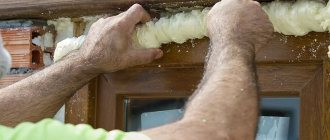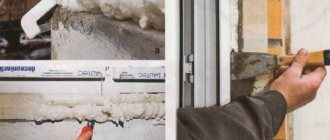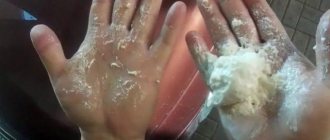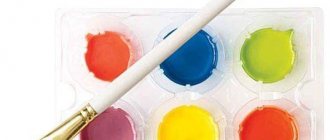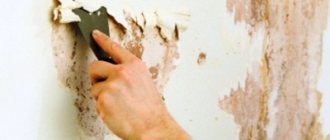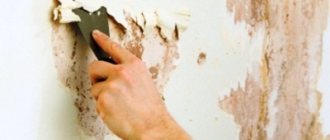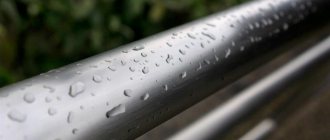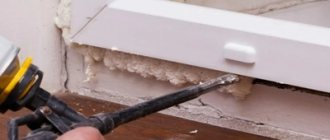The foam is blown out using a special gun. And even with the most careful work, there is a risk of foam getting on the door itself.
How to remove polyurethane foam from wooden, glass, and plastic doors? Special medications and home remedies will help eliminate it.
What is polyurethane foam?
Polyurethane foam is a polyurethane foam sealant that has high insulating properties and good adhesion to various materials. The porous structure of the chemical compound provides reliable protection from external noise and temperature changes. The substance is used to fill cracks, seams and inaccessible cavities.
After being forced out of the container, the liquid building material quickly hardens. The mounting medium does not respond to changes in humidity and air temperature, does not conduct electric current and does not crumble.
Polyurethane foam sealant is actively used for installing doors and windows for several reasons:
- hardens quickly;
- attaches to any type of coating;
- protects metal elements from corrosion;
- consists of environmentally friendly components;
- guarantees a long period of operation;
- does not require the use of additional tools.
The use of foam for installation is characterized by some nuances:
- for the building material to harden, access to fresh air is necessary;
- You cannot carry out insulation in the cold - the lower the air temperature, the longer the composition will harden;
- cylinders with high-quality mounting agents have a high cost;
- The sealant is not suitable for external finishing - it must be covered with facing material.
How quickly it hardens
After applying polyurethane foam to any material, it hardens. The process takes place in two stages:
- Setting - within 20 minutes from the moment of contact with the surface, the outer layer of insulation dries. At this stage, the foam looks like a pasty porous mass that gradually expands.
- Curing is the internal hardening of the sealant. Depending on the ambient temperature, moisture level and brand of installation agent, hardening lasts from 4 to 12 hours.
Before filling the cracks, it is necessary to protect the door leaf from contamination with building materials. All areas that may get foam are sealed with masking tape or film.
How to clean fresh?
The polyurethane foam used during installation has a viscous consistency at the time of application and has the ability to expand, filling holes and gaps. When exposed to air, the material begins to harden .
The curing process takes from 7 to 12 hours. During this time, the sealant should not be touched with bare hands. Otherwise, you will have to solve a new problem - how to clean your hands.
If flakes of polyurethane foam get on the door itself, you can remove them before they harden. But at the joints it is advisable not to touch the sealant so as not to disrupt its insulating ability.
The bulk of fresh polyurethane foam that gets on the door can be removed with a plastic spatula or wooden scraper . It is necessary to make clear, sharp movements with the tool, without smearing the composition over an even larger area.
The solvent will help remove the remaining sealant. The most harmless way is to use a rag soaked in vegetable oil. But you can use other means. In this case, it is necessary to take into account the material of the door itself.
In most situations, the following drugs are suitable:
- white spirit technical liquid;
- acetone-containing compounds;
- table vinegar;
- purchased polyurethane foam cleaners.
Fresh foam should not be washed with water, since contact with any wet surface accelerates adhesion and hardening.
Cleansing Products Review
Not all cleaning products are suitable for sensitive surfaces. To prevent the substance from corroding the door leaf, you must first consult with the seller at a hardware store. Among the most common cleaners are the following:
- Acetone is a clear liquid with a characteristic pungent odor. Cleans any material, but not suitable for plastic.
- Cosmofen 5, 10, 20 - means for removing old sealant. The composition contains powerful household chemicals that can dissolve the door leaf.
- Macroflex - removes uncured foam, cleans the gun.
- Solvent 646-647 is an aggressive liquid that removes stubborn stains from metal coatings, products made of MDF, PVC, but is not used for plastic.
- IsoFoam R621 is a product for cleaning the mounting gun from unhardened foam.
- Soudal PU Remover is a paste for cleaning smooth surfaces. After application, the substance along with the sealant is removed without a trace with a spatula.
Reasons for hitting the door
Installation of door frames of various types involves the use of polyurethane foam to fix the structure and seal gaps and voids . Excellent performance characteristics and ease of application have made foam a popular building material. But when using it, sometimes unforeseen situations happen . Careless handling of polyurethane sealant leads to a certain amount of the composition getting onto the canvas, which can lead to damage to the integrity of the coating and loss of its original appearance. This can happen for several reasons:
Foam Soudal Construction and Repair 500 ml. Photo Petrovich
Little experience of the work performer leads to incorrect determination of the required amount of mixture coming out of the cylinder. When expanding, the composition increases significantly in volume, the excess protrudes from the gap and ends up on the canvas or additional parts.
Use of household foam , produced in cylinders with a plastic tube. This mechanism (unlike a professional pistol) does not allow you to control the exit speed and foam consumption . When the valve is closed, the mixture continues to flow from the cylinder for some time. Careless pressing of the valve may result in spraying of the composition. When the foam runs out, it comes out of the container in jerks along with the remaining gas , the spray flies out of the container at high speed and hits not only the surface being treated, but also the surrounding elements.
Using low-quality foam will most likely lead to unsatisfactory results. Therefore, regardless of the complexity and responsibility of the work, it is recommended to choose products from well-known brands, for example, TECHNONICOL, Makroflex, Soudal, Tytan. And purchases must be made from trusted trading companies.
Thus, before you start doing the work yourself, you need to find out how it is possible to remove foam from the entrance and interior doors.
Removing cured foam
Cured sealant can only be removed using mechanical methods. The top part of the building material is cut off with a knife, blade or razor, and then the remaining clumps of foam are carefully scraped off. If there is a threat of surface damage, resort to the use of solvents.
The most accessible solution is acetone. It is suitable for cleaning durable materials, but is not used on laminated or varnished door leaves. Some substances can easily be found in your home or garage: nail polish remover, gasoline, white spirit.
All solvents are suitable for smooth surfaces, but does anyone know how to remove polyurethane foam from powder-coated doors. Just take a foam sponge and rub the dirty area with the rough side. The layer of powdered metal is susceptible to chemicals; the effect of these substances should be tested in inconspicuous areas. Do not wash off the polyurethane foam with water - this will speed up the hardening process.
How to ensure surface protection during work
Even a professional builder cannot boast of the complete absence of unwanted lumps of foam. Therefore, if it is impossible to avoid polyurethane foam stains, it is necessary to protect all surfaces from them. Repair experts recommend following three rules.
- Work clothes. Be sure to pick up things that you will throw away with a light heart after renovation. It is very difficult to wash construction foam from clothes. Remember that most often your hands and hair suffer from working with foam. Therefore, be sure to wear rubber gloves and do not take them off under any circumstances. Pull a hat over your head or tie a scarf, completely hiding your curls under the headdress. Neglecting the rule can lead to an unplanned haircut.
- Rescue oilcloth. Don't rely on your super accuracy. Light foam can quickly contaminate adjacent surfaces. Therefore, before starting work, prepare the area by covering with film all objects located in the area of work with sealant.
- Vegetable oil. This is another home trick that will help protect varnished or painted surfaces from foam. Before work, generously lubricate them with vegetable oil. In this case, lumps of sealant, even if they get to the surface, will not stick. Polyurethane foam does not have the ability to adhere to oily coatings.
Removing uncured mixture
You can remove stains from polyurethane foam at the initial stage of hardening with a spatula or knife. Fresh sealant comes off without much effort, but for a slightly thickened mass the following substances are used:
- acetone;
- assembly gun cleaner;
- vegetable oil;
- White Spirit;
- nail polish remover;
- petrol.
After removing the protruding parts of the foam, the stains are intensively wiped until completely softened. Lumps of sealant are wiped off with a sponge or thick cloth soaked in a soap solution.
It is not recommended to use oil when cleaning door leaves made of wood or MDF - stubborn greasy stains cannot be removed.
Features of cleaning various materials
The foam remaining after installation is not difficult to remove from the door, if you take into account the characteristics of the material from which it is made. If several types of materials are used, the nuances of processing each should be taken into account.
Metal
Metal doors can be cleaned from polyurethane foam using special solvents, Dimexide or any other product. The selected product is applied for a quarter of an hour, after which it is removed with napkins or rags.
Steel is not subject to chemical reactions with solvents, and allows the use of mechanical cleaning methods. For ease of cleaning, it is recommended to remove drips only after preliminary softening with solvents.
Wood, MDF
It is most convenient to clean varnished wooden doors from foam marks not immediately, but wait until the sealant begins to harden. When the foam becomes rubber-like in consistency, the mark can be removed by prying up the edge.
If the mark still remains on the surface, it will have to be modified with a cleaner, pharmaceutical Dimexide or another solvent.
Eco-veneer
In terms of its composition, eco-veneer is a composite material , which contains wood shavings and a synthetic component.
It is not worth cleaning such a door with Dimexide, as there is a risk of damaging the structure of the door itself.
Since the material has a fairly high resistance to mechanical stress, a cleaning approach with soda and a damp sponge can be used . White spirit is also suitable.
Wiping dirt off eco-veneer may require effort, since the material has a textured, uneven surface.
Glass
Glass inserts are most often found on interior doors. Like other surfaces, glass can become dirty with fresh foam. If splashes are noticed immediately, they can be easily removed with an oily rag.
It is better to apply vegetable oil to the stain for a quarter of an hour - this will give a greater effect. After this, greasy stains from the glass can be easily removed with a soap solution and any means for cleaning mirrors and glass.
Old sealant marks can be removed using special products or home recipes. It is possible to use oil, Dimexide, and acetone.
Plastic
Foam from plastic doors can be removed with a table bite. It is applied to the stain and tinder. Special foam cleaners will also help clean the surface.
How to clean varnished wood panels and MDF
The sealant is most easily removed at the setting stage, since in this state the chemical compound is susceptible to mechanical action. Contamination is removed by lightly pulling on the protruding edges.
But not everyone knows how to remove polyurethane foam from a varnished wooden door if the material has long hardened. Typically, Dimexide is used, a drug that destroys the structure of the sealant. Cleansing is carried out in this way:
- cut off the protruding part of the building material, avoiding damage to the wooden panel or MDF;
- moisten a piece of fabric in the cleaner and treat the stain for several minutes;
- After the foam has softened, remove the residue with a sponge or toothbrush.
Dimexide corrodes skin cells, so you should wear gloves when handling the drug.
To avoid accidental lightening of the door leaf, Dimexide is tested in an inconspicuous place. A drop of the substance is kept on the surface for 10-15 minutes. If the wood is not deformed or lightened, proceed to cleaning the contaminated areas.
Precautionary measures
Construction foam is a highly adhesive product. Therefore, the molecules of the composition penetrate deep into the structure of the material and bind tightly to it. Therefore, it is better to take precautions when working with such a product. The door structure should be protected with a special polyethylene film. This material is secured with tape. The protective film should be applied to those areas where the sealant may accidentally get in contact. This applies not only to the door, but also to the floor. Then you won’t have to rack your brains over how and with what to wash off this product.
How to remove dried foam from eco-veneer
Eco-veneer is used to imitate the natural structure of wood. It is produced by pressing wood fibers and a bonding chemical. Dimexide is not used to remove dried sealant from eco-veneer - the product corrodes the fibers of the material.
Veneered doors are cleaned mechanically in two stages:
- the sealant is cut off with a thin sharp object (blade, knife, spatula);
- the remaining foam is treated with baking soda and then removed with a damp sponge.
Grains of soda will not spoil the coating, since eco-veneer is a durable material that is resistant to mechanical damage. It does not form scratches, chips or dents.
An alternative method for removing foam clots is to use white spirit. Exposure to the solvent will allow you to remove the contamination using a dry cloth.
What not to do to remove foam from a door leaf
Respirator Source FFP1 with valve. Photo by Leroy Merlin
When removing foam, you must remember several prohibitions:
- Work should not be carried out without personal protective equipment: gloves and a respirator;
- It is not recommended to cut the frozen mass with a knife to the very base, this increases the likelihood of damage to the canvas;
- Solvents and cleaners should not be left on the surface longer than indicated on the packaging, as this may damage the surface;
- Do not spread the foam over the surface; the composition must be removed with sudden movements;
- you should not try to wash off uncured foam, water only strengthens the adhesion of the mixture to the base;
- It is necessary to use a sponge of moderate hardness, but do not use a metal mesh, as it can damage the finish.
Cleaning glass and decorative inserts of interior doors
Some interior door designs contain glass inserts. Decorative glass elements are cleaned from foam using vegetable oil or vinegar. The only condition is that the building material must be fresh. The procedure is as follows:
- the foam is separated with a knife, the remains are treated with table vinegar or oil;
- after 15-20 minutes, the softened mass is removed with a soft sponge;
- The oil stain is washed off with a soap solution.
It will not be possible to mechanically clean glass from frozen foam, since the coating will be scratched. Building materials stores sell special solvents that are suitable for glass surfaces.
Depending on the extent and duration of the contamination, different types of cleaning agents are used. Removing hardened polyurethane foam from various doors requires special skills. A suitable cleaning substance will remove stains without leaving a trace and keep your home looking attractive.
Home remedies
To effectively and safely clean the door from construction foam with your own hands, it is not necessary to buy a special solvent. You can use what you have at home. For example, the following tools are suitable:
- sunflower oil;
- table vinegar;
- dimexide;
- White Spirit.
These options are better than a specialized cleaner in that they are cheaper, but no less effective. In addition, they are affordable and are almost always available at home. They can be purchased at any retail outlet.
Vegetable oil
Vegetable oil can easily remove fresh construction foam from the surface of the door. It is also used for frozen contamination. But in this case the effect will be much weaker. There is no point in removing a thick layer of foam with oil alone. After all, a fatty substance will not soften the dense composition. Therefore, most of the foam is removed with a scraper. And they try to wipe off the remaining foam with vegetable oil.
Vinegar
Ordinary table vinegar is often used as a solvent. All thanks to the high acid content. Use this product undiluted. Soak a napkin or cotton pad in vinegar and wipe the stain with it. Wait time for the acid to react with the components of the construction foam. The dirt softens and is easily removed with a scraper.
Dimexide
Dimexide is sold at any pharmacy. This product is affordable. Acts as an effective solvent. It is used in its pure form. To do this, the drug is applied to a rag or sponge. Treat contamination. The stain should be thoroughly soaked. You can keep the composition on the door leaf for no more than two minutes. During this time, the foam will soften and can be removed with a scraper.
White Spirit
White spirit is an effective solvent against various types of contaminants. Sold in a specialized store. It is easy to use. Apply white spirit to the area stained with construction foam and wait until 0.5-1 minutes. Then wipe off the softened polyurethane foam with a rag.
What can you use for cleansing?
If there are vinyl or plastic elements on the door, then acetone cannot be used.
Such materials should be cleaned with COSMOFEN 10, which scrubs well both fresh and dried foam, since it can soften hardened material. Products for removing polyurethane foam
Cleaning begins with mechanical cleaning. But when choosing a tool, you should take into account the material from which the door is made:
- A sharp knife, blade or spatula is suitable for iron, varnished and wooden surfaces;
- Veneer products should be cleaned with a wooden spatula or a glass ceramic scraper.
Next, the remaining traces are removed.
For this purpose, you can purchase a specialized product at any construction supermarket. To remove fresh foam, use PENOSIL Foam Cleaner, Waller, Ultima Professional or Oppa. And if the sealant has already hardened, then its remains can be removed using PENOSIL Premium Cured PU-Foam Remover. Such products are sold in cylinders, like construction foam. The solvent is applied to the remaining foam and removed with a napkin after 10-15 minutes. These cleaners contain acetone, which, together with foam, can remove the paint layer of the door leaf. Let's consider more gentle, but no less effective ways to eliminate traces of polyurethane foam.
Frequent mistakes and, as a result, a scratched surface or what should not be done
The most common mistake made by home craftsmen working with polyurethane foam when installing or repairing entrance and interior doors is trying to wash off a still fresh stain with water. Such actions will lead to the spread of contamination along the plane and also accelerate its hardening.
When deciding how to wipe off the door surfaces from the sealant that has had time to harden without scratching them, avoid excessive pressure on the spatula or knife when cutting off the sagging. There is no need to rush and you will avoid damage.
What is a sealant?
Surely everyone knows that sealant is a product that is usually sold in cans. It is used to remove various gaps that may appear during installation. But not everyone knows what components make up the foam, and why it is so difficult to clean. The cylinder is under high pressure and contains two main components:
- Prepolymer. Its form is liquid, and is a complex of complex organic compounds. Contact with air causes polymerization and polyurethane foam is formed.
- Propellant. It is a mixture of gases in liquid and gaseous forms. The task of the substance is to push out the composition and promote the formation of bubbles.
A distinctive feature of the sealant is its high adhesion to almost any building material. This is a huge plus in installation and construction work. But cleaning the surface for the same reason becomes quite difficult and requires considerable effort.
The sealant itself can have three states. The first of these is the state of readiness, in other words, the foam is still in the cylinder. The next state is the moment of polymerization. This occurs when the foam is already on the surface, but has not yet fully hardened. And the last state is complete polymerization. It is a hard consistency when it is completely dry. Cleaning may be necessary in one of the last two states.
Precautions to effectively remove the mixture
Polyurethane foam is a product that can penetrate deep layers of the base . This property is the reason for the difficulties that arise when removing the composition . In order to avoid difficulties and problems, before performing work, it is recommended to cover the surface of the canvas and the box with film and secure it with tape. The contractor also needs protection , especially if the work is carried out using aggressive means. Thick rubber gloves are used to protect hands . The use of products with a strong odor, such as acetone or white spirit, requires the performer to wear a respirator or gauze bandage . The effect of the substance on the material is checked on an inconspicuous area of the door. Just apply a few drops to the surface and wait 15 minutes. The absence of damage allows the product to be used for its intended purpose.
Why is foam so difficult to remove?
In order to understand how to effectively wipe off foam, you need to understand its properties. This sealant has amazing retention, heat and sound insulation properties, and at the same time it is simple and convenient to use.
Compressed foam, leaving the can through the gun, increases several times. At the same time, it is saturated with many tiny bubbles, which collapse and securely adhere to the base. The process of adhesion occurs - the penetration of one substance into another at the molecular level.
It turns out that as soon as the foam sealant touches any surface, it immediately firmly penetrates its structure. And even if you did a good job eliminating the excess and no traces are visible, know that some part of the composition still remains.
It is also worth considering that the more moistened an object is, the more firmly the foam “sits” on it. This is why it is so difficult to remove the product from your hands, and it becomes obvious that trying to wash off a fresh mark with water is a bad idea.
The conclusion suggests itself that it is better to play it safe and prevent contamination with polyurethane foam. To do this, before, during and after work, it is advisable to take the following measures:
- remove all valuable objects and furniture from the room or at least cover it with film;
- lubricate with greasy cream or Vaseline those areas that cannot be protected in any other way - for example, a window frame or door leaf;
- for work, wear the most closed clothing possible, be sure to have a hat and gloves - and the uniform should consist of those things that you don’t mind throwing away later;
- when buying a cylinder with a substance, immediately buy a cleaner or stock up on solvent and “Dimexide” - they will certainly come in handy;
- After foaming, especially large spaces, avoid drafts - they can “blow out” the sealant that has not yet hardened.
